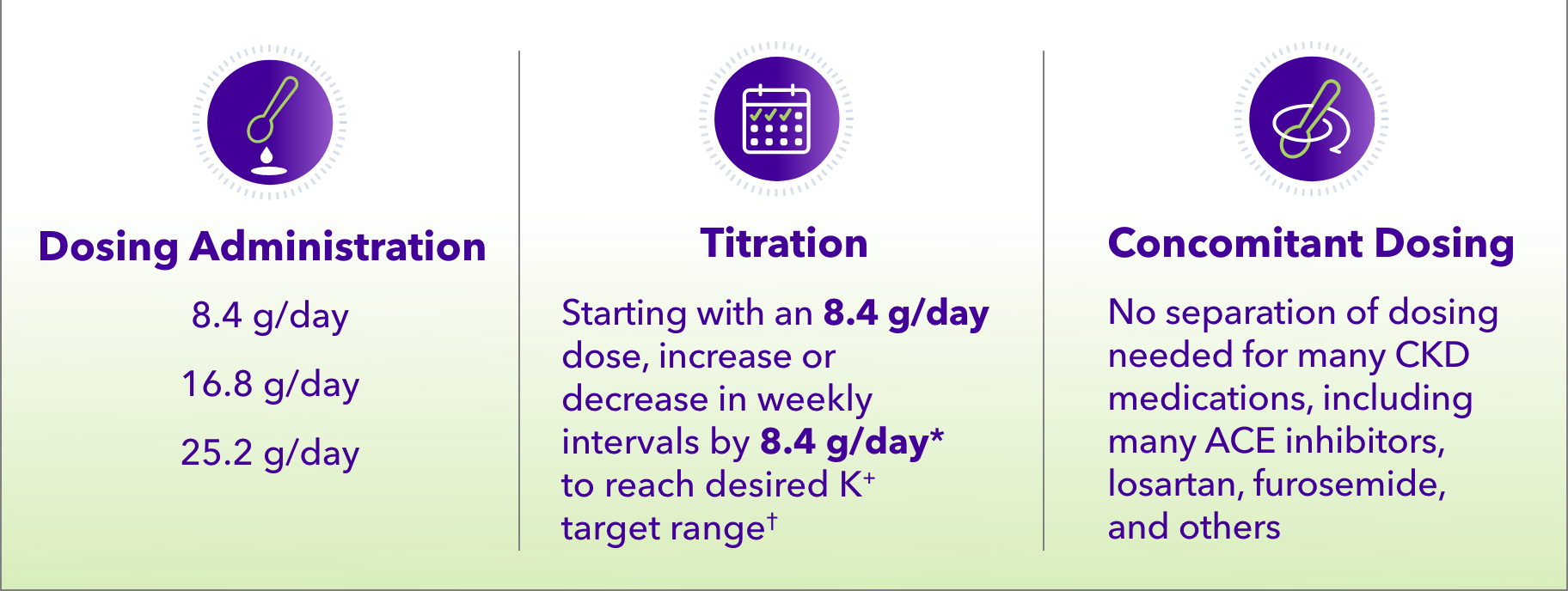VELTASSA has simple once daily dosing for all adult and pediatric patients

CKD=chronic kidney disease.
*Recommended starting dose is 8.4 g/day for adult patients.
†The maximum recommended dosage in adult and pediatric patients older than 12 years is 25.2 g once daily.
‡Recommended starting dose is 4 g/day for pediatric patients.
See Prescribing Information for a full list of drugs that do not require separation of dosing when taken with VELTASSA. For all other orally administered drugs, take at least 3 hours before or 3 hours after taking VELTASSA. Mix VELTASSA with water, other beverages, or soft foods.


VELTASSA has a variety of preparation options
NextINDICATION
VELTASSA is indicated for the treatment of hyperkalemia in adults and pediatric patients ages 12 years and older.
Limitation of Use: VELTASSA should not be used as an emergency treatment for life-threatening hyperkalemia because of its delayed onset of action.
INDICATION & Important Safety Information
Important Safety Information
VELTASSA is indicated for the treatment of hyperkalemia.
Limitation of Use: VELTASSA should not be used as an emergency treatment for life-threatening hyperkalemia because of its delayed onset of action.
CONTRAINDICATIONS
VELTASSA is contraindicated in patients with a history of a hypersensitivity reaction to VELTASSA or any of its components.
INDICATION
VELTASSA is indicated for the treatment of hyperkalemia in adults and pediatric patients ages 12 years and older.
Limitation of Use: VELTASSA should not be used as an emergency treatment for life-threatening hyperkalemia because of its delayed onset of action.
IMPORTANT SAFETY INFORMATION
CONTRAINDICATIONS
VELTASSA is contraindicated in patients with a history of a hypersensitivity reaction to VELTASSA or any of its components.
WARNINGS AND PRECAUTIONS
Worsening of Gastrointestinal Motility: Avoid use of VELTASSA in patients with severe constipation, bowel obstruction or impaction, including abnormal post-operative bowel motility disorders, because VELTASSA may be ineffective and may worsen gastrointestinal conditions. Patients with a history of bowel obstruction or major gastrointestinal surgery, severe gastrointestinal disorders, or swallowing disorders were not included in clinical studies.
Hypomagnesemia: VELTASSA binds to magnesium in the colon, which can lead to hypomagnesemia. In clinical studies, hypomagnesemia was reported as an adverse reaction in 5.3% of adult patients treated with VELTASSA. Approximately 9% of adult patients in clinical trials developed hypomagnesemia with a serum magnesium value < 1.4 mg/dL. Monitor serum magnesium. Consider magnesium supplementation in patients who develop low serum magnesium levels.
MOST COMMON ADVERSE REACTIONS
The most common adverse reactions (incidence ≥ 2%) in adult patients treated with VELTASSA were constipation (7.2%), hypomagnesemia (5.3%), diarrhea (4.8%), nausea (2.3%), abdominal discomfort (2.0%) and flatulence (2.0%). Mild to moderate hypersensitivity reactions were reported in 0.3% of adult patients treated with VELTASSA and included edema of the lips. The safety profile of VELTASSA in a study of 14 pediatric patients ages 12 to 17 years was generally similar to that observed in adult patients.



